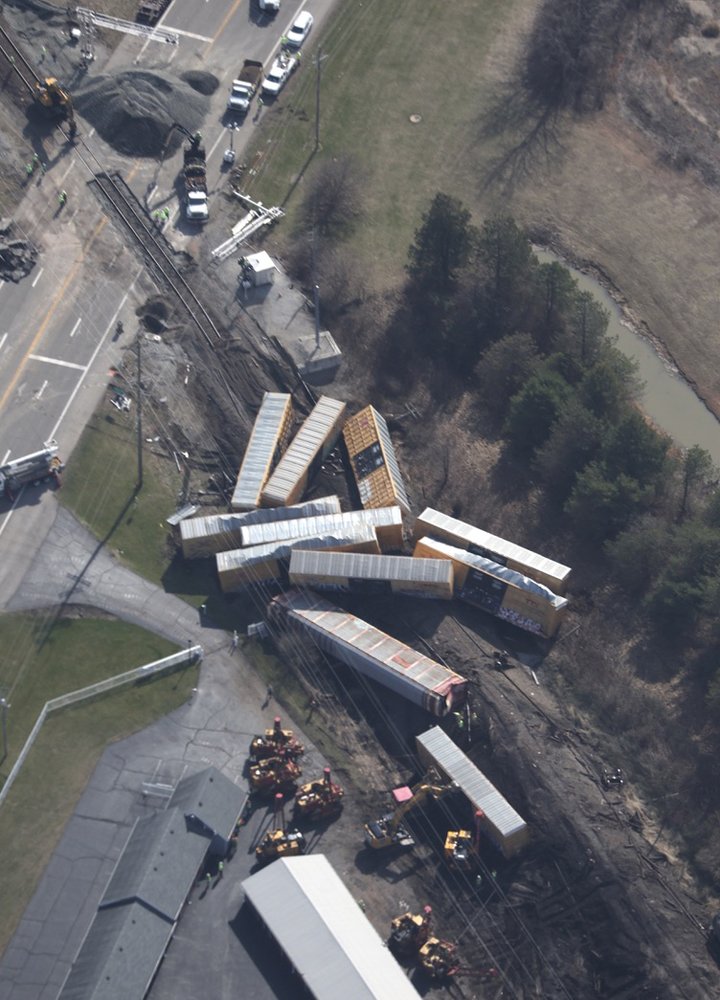
WASHINGTON — The Federal Railroad Administration on Friday issued a safety advisory calling on railroads to address potential safety risks resulting from the structure of long freight trains, saying it has “noticed a rising trend in recent incidents where train build and makeup have been identified as a potential cause or contributing factor.”
Limitations on train lengths are among the FRA’s recommended “best practices” to address the issue.
Advisory 2023-02, available here, cites six derailments since May 2021 — three on Union Pacific, one on Kansas City Southern, and two on Norfolk Southern. All involved trains of 125 or more cars; featured distributed power units; far exceeded 4,000 trailing tons, the maximum weight threshold established by a 1992 AAR guide; and had an empty car as the first to derail. Other characteristics were shared in half or more of the incidents.
The NS derailment in East Palestine, Ohio, was not among those cited, but the railroad’s March 4 derailment in Springfield, Ohio, was [see “NS train derails in Springfield …,” Trains News Wire, March 5, 2023].
“Technologies such as DPUs, energy management systems, and dynamic braking can be used in conjunction with proper train car placement and makeup,” the advisory states. “While these technologies can improve train handling and fuel efficiency, they cannot replace the need for correct car placement and assembly. Railroads must prioritize proper train makeup to maintain safety, prevent accidents, and optimize train performance. Further, all operating employees must be properly trained in these technologies and the handling of complex trains to ensure safe operation and minimize human error.”
While the basic concept of train makeup for mixed manifest trains is to place loaded cars at the front of the consist and empties at the rear, railroads use computer programs to assist with this process, and other factors, such as pre-blocking for destinations, complicate train building. Placement of DPUs is also crucial, as illustrated by a recent accident report from the Transportation Safety Board of Canada on a 2020 Canadian Pacific derailment. That accident led to CP changing the configuration of DPUs on some long grain trains [see “Failure of soft subgrade led to 2020 CP grain train derailment …,” Trains News Wire, March 22, 2023].
Among the half-dozen “best practices” recommended by the FRA are developing and implementing strategies “to mitigate the risks associated with train build factors, such as the proper use of distributed power, train length limitations, and other operational train handling practices.
Other recommendations include insuring that current train makeup policies are up to date; that personnel involved in train makeup decisions receive appropriate training; and allowing open communication regarding train makeup, with all personnel empowered to adhere to policies, even if it delays a train.
Friday’s advisory is the second issued this year by the FRA. In February, it issued recommendations regarding use of data from hotbox detectors as a result of the East Palestine derailment [see “FRA makes safety recommendations …,” News Wire, Feb. 28, 2023]. It also issued a more informal safety bulletin regarding shoving moves at highway grade crossings as a result of a March 7 fatality in Ohio [see “FRA issues safety bulletin …,” News Wire, March 17, 2023].














Has the software that the railroads use for train makeup been updated with todays equipment statistics and the use of DPU’s, those would both be a contributing factor if not(I can’t imagine they wouldn’t update the data, but you never know).
Why are railroads allowed to run monster trains approaching 15,000 tons. according to AAR guidelines, NO MORE than 4,000 tons should be allowed after DPU (roughly 30 40 cars, depending on it’s loading). That means 11,000 tons before a DPU. How do these trains get over relative flat landscape without derailing, much less in the curving mountains.
Legislation by the US Congress mandating maximum length and weight and makeup of trains is coming. This will force out most, if not all the hedge funds, that are controlling the railroads. These mandates will drive up operating ratios. Shorter trains means more trains and more crews. More trains require more sidings if not total re installation of the double trackage torn out the last 20 years. That is if they don’t go bankrupt before driving away most of their customers because of bad service.
EHH, your vision of running railroads sucks. It’s penny wise pound stupid. That is, you (the railroad industry) stopped to pick up a penny and let someone else (trucking industry) get to the more profitable pound of silver.
The same way they run 30000 ton trains in Australia…which they regularly do on the iron ore lines. Notice even you stated the trailing tonnage behind DPU’s should not exceed 4000 tons, that doesn’t mean they can’t have multiple DPU’s throughout a train consist, and I have seen trains running with 2 sets of DPU, one somewhere in the consist and one at the end.
Gerald, the iron ore lines of Australia are the only other place in the world where this happens. Lines where trains run hundreds of miles from civilization in closed routes from mine to port and back, carrying nothing but inert minerals in one solid line.
Using DPU the way PSR does is stupid and dangerous.
Pre Blocking trains has been around for decades. But it’s not always comparable with todays exceptionally long trains. Especially when the blocks have empty’s, as most could. You can either pre block or run 15K foot trains but combining both will eventually catch up with you. Simple physics.
Are there any teeth in the FRA document? It sounds like the RR’s can read it (or not) and then do whatever they want.
Several years ago Norfolk Southern had two derailments on Horseshoe Curve, both involving empty center beam flatcars near the head end of the trains. A Virtual Railfan camera caught one of the derailments as it occurred.
Mark,
You are correct.
July 5, 2019: Train 34A, 140 cars, 8900 tons, 9650 ft., derailed at the east end of Horseshoe Curve (9 degrees, 4 inches elevation, 1.8% ascending grade). Cause was train make-up: 4 empty centerbeam flats, positions 5-8 behind 3 locomotives, were pulled off the low side of the curve. Four cars ahead and three behind, all empties, also derailed.
July 26, 2019: Train 35A, 222 cars, 8775 tons, 13,500 ft., derailed at the west end of Horseshoe Curve. (The derailed cars from the July 5th derailment were still sitting in the weeds, trackside, when 35A ran by!) Cause was train make-up: 3 empty centerbeam flats, positions 1-3 behind 3 locomotives, were pulled off the low side of the curve. Three cars behind, all empties, also derailed.
I was Director Research & Tests for NS at the time and investigated both derailments. (Two months later my railroad career came to an unceremonious end, a casualty, like so many other railroaders, of the cost reduction mandates imposed by today’s Class 1 railroads.)
These two derailments are interesting for three reasons.
A change in operation between Altoona and Johnston (over the “mountain”) resulted in helper locomotives being used much less frequently. Under the previous system, Trains 34A and 35A would have each had a rear-end helper to help push the train up the grade.
Following the first derailment, NS operating people discussed the make-up of trains operating over the mountain. During this well-attended call, R&T argued that empty centerbeam flats were “restricted cars” and thus subject to trailing tonnage restrictions. The message did not sink in until after the second derailment.
Finally, and perhaps most interesting, the University of Illinois Champaign-Urbana was conducting a revenue service test associated with broken spikes (under an FRA research grant). Ten days prior to the 35A derailment, UIUC installed a strain gage measurement site at the middle of Horseshoe Curve. Thus, every wheel that ran on track 3 generated lateral and vertical strains that could be converted into lateral and vertical force values. 35A’s POD was literally several car lengths past the measurement site. The data from the head-end of the train was remarkable: The three centerbeam flats (tare 64,000 lbs.) showed 0 lbs. vertical on the high rail and 16,000 lbs. (twice their static load) on the low rail – a 100% weight transfer. Imagine the scene from the 2010 movie, Unstoppable, (starring Denzel Washington), only with the high rail unloaded and without the sparks!
Excellent information Brad. They say “…the wheels of government turn slow.” Too slow in these cases and in the FRA finally waking up to reality. Maybe Congress should give the NTSB enforcement powers since none of the other departments of the government involving transportation safety seem to want to enforce their recommendations, even when they are obvious.
Me thinks that you were let go by NS not because you were excess, but because your knowledge of buff forces and car placement was dangerous to them and under “discovery” would prove to be a liability.
Sometimes it sucks to be good at what you do
I think the practice of pre-blocking is going to be one of there big problems. If you have three, four, or more blocks your not always going to have the empties on the rear end. There going to be spreed out through the train. A block of empties could wind close or even the head end depending on there destination. I do think that the make up of the train would be the last block put on is the first block to be dropped off to cut down on switching.